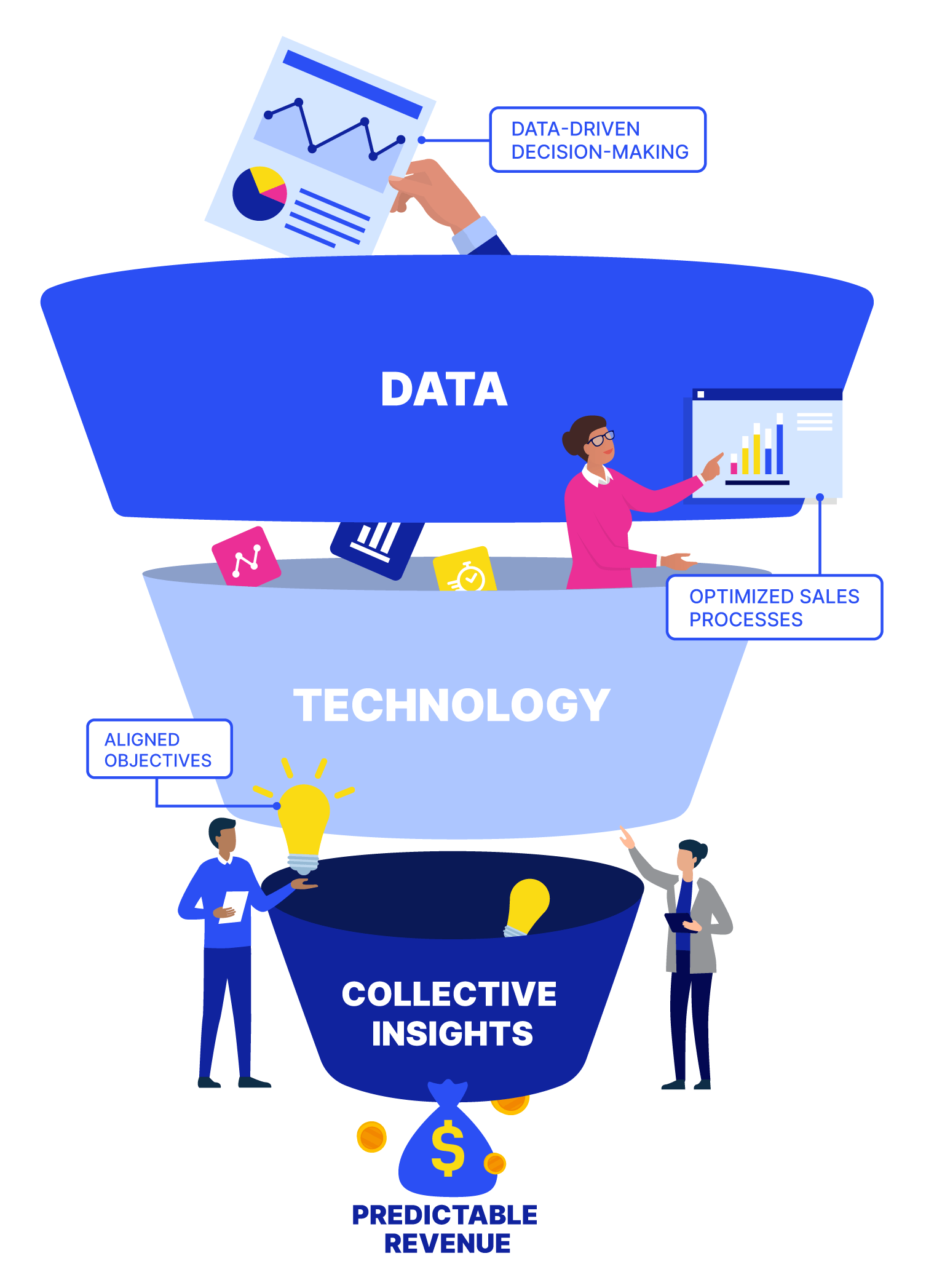
Confidence with Collaboration (data, technology, collective insights) facilitates data-driven decision-making, optimized sales processes, aligned objectives, and connecting the organization to predictable revenue streams.
In this blog, we’ll break down why collaboration is important for fighting revenue volatility. And how you can build a culture of collaboration across revenue-generating teams through connected data and technology.
A recent episode of What I Wish I Knew talks about how cross-functional collaboration helps create a more successful customer journey.
Breakdown Department Silos to Build Up Sales Efficiency
In an unpredictable market, the absence of both agility and efficiency can swiftly lead to missed sales opportunities. When internal teams collaborate more seamlessly, inefficiencies are minimized, and workflows become streamlined. Research shows that individuals who work in collaborative settings are more than 50% more effective at completing tasks than those who work independently. And, a Harvard Business Review study found that differences in perspective and information processing styles – specifically those that may come from different functional groups within a company – helps teams solve problems faster.
However, the age-old challenge of siloed departments continues to hinder effective collaboration. To bridge this gap, revenue teams can implement effective strategies that encourage open communication and knowledge sharing and ultimately lead to stronger and more predictable sales performance. Regular cross-functional meetings, joint goal-setting, and cross-training initiatives dismantle silos, and create an environment where everyone is invested in the collective sales mission. This creates a collaborative culture where insights and expertise can be freely shared, boosting morale and strengthening the collective knowledge base.
Clear Communication Enhances Sales Team Satisfaction
Speaking of boosting morale, one of the key factors causing volatility, and ultimately impacting revenue growth is seller churn – it’s now higher than ever. Promoting collaboration and clear communication not only benefits efficiency but also leads to higher employee satisfaction. Research conducted by Zippia found that companies that prioritize collaboration and communication, experience a 50% reduction in employees and a 17% improvement in overall job satisfaction.
Read more about how open communication and transparency can directly address seller turnover.
Drive Sales Growth with Data-Driven Collaboration
Data serves as a common language that transcends department barriers, providing a unified understanding of customer needs, market trends, and competitor landscapes. Cross-functional access to data, from marketing and sales, to finance and HR, empowers leaders to make more confident and informed decisions.
Without collaboration, data can be fragmented from various departments. By promoting cross-functional collaboration and establishing a shared data platform, businesses can ensure that everyone has access to reliable, real-time information. This enables teams to work together, align their efforts, and uncover valuable trends and insights that inform strategic decision-making, driving the business forward.
Sales data analysis is also a coaching tool. Learn more about the 7 ways to motivate sellers with better data analysis.
Common Tools Benefit the Common Good
When you think of digital collaboration, you often think of communication tools like Slack or Zoom. But how can technology make it easier and more efficient to share data?
An IDC study found that workers were spending two and a half hours a day looking for the right information. Surprisingly, despite technological advancements, not much has changed. Forbes found that workers still spend a significant amount of time searching for what they need.
To overcome this challenge, you need a single source of truth: one sales performance and management solution that seamlessly integrates data from various sources, providing a unified view of information. By enabling real-time access to data, you can save time and improve productivity.
Leaders can leverage this holistic view of the data to uncover valuable trends and insights, align their efforts, quickly identify opportunities, and make informed, confident decisions.
Sales Collaboration is the Antidote to Revenue Volatility
Salesforce highlighted that 86% of executives identify ineffective communication and collaboration as a major cause of failure in business. In an uncertain market, collaboration is not just a nice-to-have; it facilitates success. By breaking down silos, promoting open communication, and leveraging data and technology, you can foster a culture of collaboration that leads to confident decision-making, optimized sales processes, and alignment across teams. Embracing collaboration as a mindset rather than just a tactic will provide stability and sustainability in a disruptive market.
As you consider the state of collaboration in your organization, here are five areas to consider and questions to ask to better assess the effectiveness of collaboration across your revenue teams:
Are Silos Hindering Collaboration?
- Are there distinct departments or functional groups within the sales organization that operate in isolation?
- How frequently do teams from different departments interact and collaborate on projects or initiatives?
- What strategies can be implemented to encourage cross-functional communication and knowledge sharing?
Is Clear Communication Prioritized?
- How often does the sales team engage in open and transparent communication about goals, challenges, and insights?
- What efforts are being made to enhance communication within the team and across departments?
- Are there mechanisms in place to address any communication gaps that might be impacting morale and productivity?
Is Data-Driven Collaboration a Norm?
- How effectively is data shared and utilized across different departments, such as marketing, sales, finance, and HR?
- Are there shared data platforms or systems that provide a unified view of information for informed decision-making?
- What steps can be taken to ensure that relevant data is accessible to all teams to drive collaboration and strategic insights?
Are Technology Tools Facilitating Collaboration?
- Are the current technology tools and platforms supporting efficient data sharing and collaboration?
- How much time do team members spend searching for information or navigating between different tools?
- Can a more integrated and unified technology solution be adopted to streamline data access and improve productivity?
Is Collaboration Seen as a Strategic Mindset?
- Is collaboration viewed as a core value and strategic approach within the sales organization, rather than just a tactical effort?
- What initiatives can be introduced to foster a culture of collaboration as a means to achieve stability and revenue predictability?
- How can collaboration be integrated into the sales team's daily routines and decision-making processes?
When it comes to disruption and volatility, there are internal and external factors at play. Get your copy of Revenue Resilience: Control Volatility with Confidence for an in-depth analysis of what’s causing volatility and learn the 5 steps for building resiliency.





